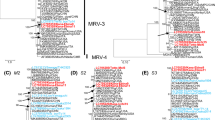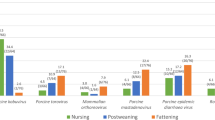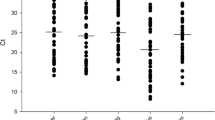Abstract
During a surveillance study to monitor porcine epidemic diarrohoea virus and transmissible gastroenteritis virus in India, a total of 1043 swine samples including faeces (n = 264) and clotted blood (n = 779) were collected and tested. Five samples (four faecal and one serum) showed cytopathic effects in Vero cells. Transmission electron microscopy of infectious cell supernatant revealed the presence of two types of virions. Next-generation sequencing (de novo) allowed the complete genome sequence of mammalian orthorubulavirus 5 (MRuV5; 15246 bp) and that of all 10 gene segments of mammalian orthoreovirus to be determined. Genetic analysis of MRuV5 revealed grouping of the Indian MRuV5 with isolates from various mammalian species in South Korea and China, sharing more than 99% nucleotide sequence identity. The deduced amino acid sequences of the HN, NP, and F genes of MRuV5 isolates showed three (92L, 111R, 447H), two (86S, 121S), and two (139T, 246T) amino acid substitutions, respectively, compared to previously reported virus strains. Phylogenic analysis based on S1 gene sequences showed the Indian MRV isolates to be clustered in lineage IV of MRV type 3, with the highest nucleotide sequence identity (97.73%) to MRV3 strain ZJ2013, isolated from pigs in China. The protein encoded by the MRV3 S1 gene was found to contain the amino acid residues 198-204NLAIRLP, 249I, 340D, and 419E, which are known to be involved in sialic acid binding and neurotropism. This is the first report of co-isolation and whole-genomic characterisation of MRuV5 and MRV3 in domestic pigs in India. The present study lays a foundation for further surveillance studies and continuous monitoring of the emergence and spread of evolving viruses that might have pathogenic potential in animal and human hosts.








Similar content being viewed by others
References
Woolhouse M, Scott F, Hudson Z, Howey R, Chase-Topping M (2012) Human viruses: discovery and emergence. Philos Trans R Soc Lond B Biol Sci 367:2864–2871. https://doi.org/10.1098/rstb.2011.0354
Parvez MK, Parveen S (2017) Evolution and emergence of pathogenic viruses: past, present, and future. Intervirology 60:1–7. https://doi.org/10.1159/000478729
Chan JFW, To KKW, Tse H, Jin DY, Yuen KY (2013) Interspecies transmission and emergence of novel viruses: lessons from bats and birds. Trends Microbiol 21:544–555. https://doi.org/10.1016/j.tim.2013.05.005
Terrier O, Rolland JP, Rosa-Calatrava M, Lina B, Thomas D, Moules V (2009) Parainfluenza virus type 5 (PIV-5) morphology revealed by cryo-electron microscopy. Virus Res 142:200–203. : https://doi.org/10.1016/j.virusres.2008.12.017
Henrickson KJ (2003) Parainfluenza viruses. Clin Microbiol Rev 16:242–264. https://doi.org/10.1128/CMR.16.2.242-264.2003
Lee YN, Lee C (2013) Complete genome sequence of a novel porcine parainfluenza virus 5 isolate in Korea. Ach Virol 158:1765–1772. https://doi.org/10.1007/s00705-013-1770-z
Chatziandreou N, Stock N, Young D, Andrejeva J, Hagmaier K, McGeoch DJ, Randall RE (2004) Relationships and host range of human, canine, simian and porcine isolates of simian virus 5 (parainfluenza virus 5). J Gen Virol 85:3007–3016. https://doi.org/10.1099/vir.0.80200-0
Liu Y, Li N, Zhang S, Zhang F, Lian H, Hu R (2015) Parainfluenza virus 5 as possible cause of severe respiratory disease in calves, China. Emerg Infect Dis 21:2242–2244. https://doi.org/10.3201/eid2112.141111
Zhai JQ, Zhai SL, Lin T, Liu JK, Wang HX, Li B, Zhang H, Zou SZ, Zhou X, Wu MF, Chen W, Luo ML (2017) First complete genome sequence of parainfluenza virus 5 isolated from lesser panda. Arch Virol 162:1413–1418. https://doi.org/10.1007/s00705-017-3245-0
Jiang N, Wang E, Guo D, Wang X, Su M, Kong F, Yuan D, Zhai J, Sun D (2018) Isolation and molecular characterization of parainfluenza virus 5 in diarrhea-affected piglets in China. J Vet Med Sci 80:590–593. https://doi.org/10.1292/jvms.17-0581
Shatkin AJ, Sipe JD, Loh P (1968) Separation of ten reovirus genome segments by polyacrylamide gel electrophoresis. J Virol 2:986–991. https://doi.org/10.1128/JVI.2.10.986-991.1968
Nibert ML, Schiff LA (2001) Reoviruses and their replication. In: Knipe DM, Howley PM (eds) Fields Virology, 4th edn. Lippincott Williams and Wilkins, Philadelphia, pp 1679–1728
Lelli D, Moreno A, Steyer A, Nagliˇc T, Chiapponi C, Prosperi A, Faccin F, Sozzi E, Lavazza A (2015) Detection and characterization of a novel reassortant mammalian orthoreovirus in bats in Europe. Viruses 7:5844–5854. https://doi.org/10.3390/v7112908
Rosa UA, Ribeiro GO, Villanova F, Luchs A, Milagres FAP, Komninakis SV, Tahmasebi R, Lobato MCABS, Brustulin R, Chagas RTD, Abrão MFNDS, Soares CVDA, Tinker RJ, Pandey RP, Raj VS, Sabino EC, Deng X, Delwart E, Costa ACD, Leal É (2019) First identification of mammalian orthoreovirus type 3 by gut virome analysis in diarrheic child in Brazil. Sci Rep 9:18599. https://doi.org/10.1038/s41598-019-55216-5
Fields BN (1982) Molecular basis of Reovirus virulence. Arch Virol 71:95–107. https://doi.org/10.1007/BF01314880
Furlong DB, Nibert ML, Fields BN (1988) Sigma 1 protein of mammalian reoviruses extends from the surfaces of viral particles. J Virol 62:246–256. https://doi.org/10.1128/JVI.62.1.246-256.1988
Fraser RD, Furlong DB, Trus BL, Nibert ML, Fields BN, Steven AC (1990) Molecular structure of the cell-attachment protein of reovirus: correlation of computer-processed electron micrographs with sequence-based predictions. J Virol 64:2990–3000. : https://doi.org/10.1128/JVI.64.6.2990-3000.1990
Weiner HL, Fields BN (1977) Neutralization of reovirus: the gene responsible for the neutralization antigen. J Exp Med 146:1305–1310. https://doi.org/10.1084/jem.146.5.1305
Weiner HL, Raming RF, Mustoe TA, Fields BN (1978) Identification of the gene coding for the hemagglutinin of reovirus. Virol 86:581–584. https://doi.org/10.1016/0042-6822(78)90099-5
Weiner HL, Ault KA, Fields BN (1980) Interaction of reovirus with cell surface receptors. I. Murine and human lymphocutes have a receptor for the emagglutinin of reovirus type 3. J Immunol 124:2143–2148
Lee PW, Hayes EC, Joklik WK (1981) Protein s1 is the reovirus cell attachment protein. Virol 108:156–163. https://doi.org/10.1016/0042-6822(81)90535-3
Bassel-Duby R, Spriggs DR, Tyler KL, Fields BN (1986) Identification of attenuating mutations on the reovirus type 3 S1 double-stranded RNA segment with a rapid sequencing technique. J Virol 60:64–67. https://doi.org/10.1128/JVI.60.1.64-67.1986
Day JM (2009) The diversity of the orthoreoviruses: molecular taxonomy and phylogentic divides. Infect Genet Evol 9:390–400. https://doi.org/10.1016/j.meegid.2009.01.011
Kwon HJ, Kim HH, Kim HJ, Park JG, Son KY, Jung J, Lee WS, Cho KO, Park SJ, Kang MI (2012) Detection and molecular characterization of porcine type 3 orthoreoviruses circulating in South Korea. Vet Microbiol 157:456–463. https://doi.org/10.1016/j.vetmic.2011.12.032
Tyler KL (2001) Mammalian reoviruses. In: Knipe DM, Howley PM (Eds), Fields Virology. 4thEd. Lippincott Williams and Wilkins, Philadelphia, pp 1729–45
Tyler KL, Barton ES, Ibach ML, Robinson C, Campbell JA, O’Donnell SM, Valyi-Nagy T, Clarke P, Wetzel JD, Dermody TS (2004) Isolation and molecular characterization of a novel type 3 reovirus from a child with meningitis. J Infect Dis 189:1664–1675. https://doi.org/10.1086/383129
Steyer A, Gutiérrez-Aguire I, Kolenc M, Koren S, Kutnjak D, Pokorn M, Poljšak-Prijatelj M, Racki N, Ravnikar M, Sagadin M, Fratnik Steyer A, Toplak N (2013) High similarity of novel orthoreovirus detected in a child hospitalized with acute gastroenteritis to mammalian orthoreoviruses found in bats in Europe. J Clin Microbiol 51:3818–3825. https://doi.org/10.1128/JCM.01531-13
Zhang C, Liu L, Wang P, Liu S, Lin W, Hu F, Wu W, Chen W, Cui S (2011) A potentially novel reovirus isolated from swine in northeastern China in 2007. Virus Genes 43:342–349. https://doi.org/10.1007/s11262-011-0642-4
Thimmasandra Narayanappa A, Sooryanarain H, Deventhiran J, Cao D, Ammayappan Venkatachalam B, Kambiranda DM, LeRoith T, Heffron CL, Lindstrom NM, Hall K, Jobst PM, Sexton C, Meng X, Elankumaran S (2015) A novel pathogenic mammalian orthoreovirus from diarrheic pigs and swine blood meal in the United States. MBio 6:593. https://doi.org/10.1128/mBio.00593-15
Lelli D, Beato MS, Cavicchio L, Lavazza A, Chiapponi C, Leopardi S, Baioni L, Benedictis PD, Moreno A (2016) First identification of mammalian orthoreovirus Type 3 in diarrheic pigs in Europe. Virol J 13:139. https://doi.org/10.1186/s12985-016-0593-4
Qin P, Li H, Wang JW, Wang B, Xie RH, Xu H, Zhao LY, Li L, Pan Y, Song Y, Huang YW (2017) Genetic and pathogenic characterization of a novel reassortant mammalian orthoreovirus 3 (MRV3) from a diarrheic piglet and seroepidemiological survey of MRV3 in diarrheic pigs from east China. Vet Microbiol 208:126–136. https://doi.org/10.1016/j.vetmic.2017.07.021
Dikid T, Jain SK, Sharma A, Kumar A, Narain JP (2013) Emerging & re-emerging infections in India: an overview. Indian J Med Res 138:19–31
Borkenhagen LK, Mallinson KA, Tsao RW, Ha SJ, Lim WH, Toh TH, Anderson BD, Fieldhouse JK, Philo SE, Chong KS, Lindsley WG, Ramirez A, Lowe JF, Coleman KK, Gray GC (2018) Surveillance for respiratory and diarrheal pathogens at the human-pig interface in Sarawak, Malaysia. PLoS ONE 13:e0201295. https://doi.org/10.1371/journal.pone.0201295
Kim O, Choi C, Kim B, Chae C (2000) Detection and differentiation of porcine epidemic diarrhoea virus and transmissible gastroenteritis virus in clinical samples by multiplex RT-PCR. Vet Rec 146:637–640. https://doi.org/10.1128/jcm.30.6.1365-1373.1992
Gentsch JR, Glass RI, Woods P, Gouvea V, Gorziglia M, Flores J, Das BK, Bhan MK (1992) Identification of group A rotavirus gene 4 types by polymerase chain reaction. J Clin Microbiol 30:1365–1373. https://doi.org/10.1128/jcm.30.6.1365-1373.1992
Boros A, Pankovics P, Reuter G (2011) Characterization of a novel porcine enterovirus in domestic pig in Hungary. Infect Genet Evol 11:1096–1102. https://doi.org/10.1016/j.meegid.2011.04.003
Krumbholz A, Wurm R, Scheck O, Birch-Hirschfeld E, Egerer R, Henke A, Wutzler P, Zell R (2003) Detection of porcine teschoviruses and enteroviruses by LightCycler real-time PCR. J Virol Methods 113:51–63. https://doi.org/10.1016/s0166-0934(03)00227-1
Liu JK, Wei CH, Yang XY, Dai AL, Li XH (2015) Simultaneous detection and differentiation of porcine circovirus type 2, type 2 porcine reproductive and respiratory syndrome virus, porcine parvovirus and pseudorabies virus in pigs with postweaning multisystemic wasting syndrome (PMWS) by multiplex PCR. Vet Arh 85:511–521
Decaro N, Campolo M, Desario C, Ricci D, Camero M, Lorusso E, Elia G, Lavazza A, Martella V, Buonavoglia C (2005) Virological and molecular characterization of a mammalian orthoreovirus type 3 strain isolated from a dog in Italy. Vet Microbiol 109:19–27. https://doi.org/10.1016/j.vetmic.2005.05.014
Leary TP, Erker JC, Chalmers ML, Cruz AT, Wetzel JD, Desai SM, Mushahwar IK, Dermody TS (2002) Detection of mammalian reovirus RNA by using reverse transcription-PCR: sequence diversity within the lambda3-encoding L1 gene. J Clin Microbiol 40:1368–1375. https://doi.org/10.1128/JCM.40.4.1368-1375.2002
Ouattara LA, Barin F, Barthez MA, Bonnaud B, Roingeard P, Goudeau A, Castelnau P, Vernet G, Paranhos-Baccalà G, Komurian-Pradel F (2011) Novel human reovirus isolated from children with acute necrotizing encephalopathy. Emerg Infect Dis 17:1436–1444. https://doi.org/10.3201/eid1708.101528
Meng XJ (2012) Emerging and re-emerging swine viruses. Transbound Emerg Dis 59:85–102. https://doi.org/10.1111/j.1865-1682.2011.01291.x
Perfumo CJ, Pereda A, Jongkaewwattana A, Chen Z, Perez DR, Ma J (2020) Editorial: emerging swine viruses. Front Vet Sci 7:132. https://doi.org/10.3389/fvets.2020.00132
Liu C, Li X, Zhang J, Yang L, Li F, Deng J, Tan F, Sun M, Liu Y, Tian K (2017) Isolation and genomic characterization of a canine parainfluenza virus type 5 strain in China. Arch Virol 162:2337–2344. https://doi.org/10.1007/s00705-017-3387-0
Goswami KK, Lange LS, Mitchell DN, Cameron KR, Russell WC (1984) Does simian virus 5 infect humans? J Gen Virol 65:1295–1303. https://doi.org/10.1099/0022-1317-65-8-1295
Heinen E, Herbst W, Schmeer N (1998) Isolation of a cytopathogenic virus from a case of porcine reproductive and respiratory syndrome (PRRS) and its characterization as parainfluenza virus 2. Arch Virol 143:2233–2239. https://doi.org/10.1007/s007050050454
Charoenkul K, Nasamran C, Janetanakit T, Chaiyawong S, Bunpapong N, Boonyapisitsopa S, Tangwangvivat R, Amonsin A (2021) Molecular detection and whole genome characterization of Canine Parainfluenza type 5 in Thailand. Sci Rep 11:3866. https://doi.org/10.1038/s41598-021-83323-9
Chappell JD, Barton ES, Smith TH, Baer GS, Duong DT, Nibert ML, Dermody TS (1998) Cleavage susceptibility of reovirus attachment protein sigma1 during proteolytic disassembly of virions is determined by a sequence polymorphism in the sigma1 neck. J Virol 72:8205–8213. https://doi.org/10.1128/JVI.72.10.8205-8213.1998
Lelli D, Moreno A, Lavazza A, Bresaola M, Canelli E, Boniotti MB, Cordioli P (2013) Identification of Mammalian orthoreovirus type 3 in Italian bats. Zoonoses Public Health 60:84–92. https://doi.org/10.1111/zph.12001
Besozzi M, Lauzi S, Lelli D, Lavazza A, Chiapponi C, Pisoni G, Viganò R, Lanfranchi P, Luzzago C (2019) Host range of mammalian orthoreovirus type 3 widening to alpine chamois. Vet Microbiol 230:72–77. https://doi.org/10.1016/j.vetmic.2019.01.012
McDonald SM, Nelson MI, Turner PE, Patton JT (2016) Reassortment in segmented RNA viruses: mechanisms and outcomes. Nat Rev Microbiol 14:448–460. https://doi.org/10.1038/nrmicro.2016.46
Acknowledgements
The authors are thankful to the Indian Council of Agricultural Research, New Delhi, for funding to carry out this study. We also thank the staff of the Department of Animal Husbandry and Veterinary of the Government of Mizoram, Assam and Chhattisgarh, who helped in collection of blood and faecal samples from pigs.
Funding
The present research work was carried out under the institutional project entitled “Diagnostic preparedness for porcine epidemic diarrhoea and transmissible gastroenteritis in pigs” (Project code IXX 13779) funded by the Indian Council of Agricultural Research, New Delhi, through institutional research contingency.
Author information
Authors and Affiliations
Contributions
All authors contributed to the study conception and design. Samples were collected by FS, KR, DS, and GV. Material preparation, laboratory tests and analyses were performed by FS, KR, DS, DS, SK, and SKJ. The first draft of the manuscript was written by FS and KR, and all authors commented on previous versions of the manuscript. All authors read and approved the final manuscript.
Corresponding author
Ethics declarations
Conflict of interest
The authors have no relevant financial or non-financial interests to disclose.
Research involving human participants and/or animals
This study did not involve any human participants or animals.
Additional information
Handling Editor: Ana Cristina Bratanich.
Publisher's Note
Springer Nature remains neutral with regard to jurisdictional claims in published maps and institutional affiliations.
Rights and permissions
About this article
Cite this article
Singh, F., Rajukumar, K., Senthilkumar, D. et al. First report on co-isolation and whole-genomic characterisation of mammalian orthorubulavirus 5 and mammalian orthoreovirus type 3 from domestic pigs in India. Arch Virol 167, 1529–1545 (2022). https://doi.org/10.1007/s00705-022-05459-x
Received:
Accepted:
Published:
Issue Date:
DOI: https://doi.org/10.1007/s00705-022-05459-x




